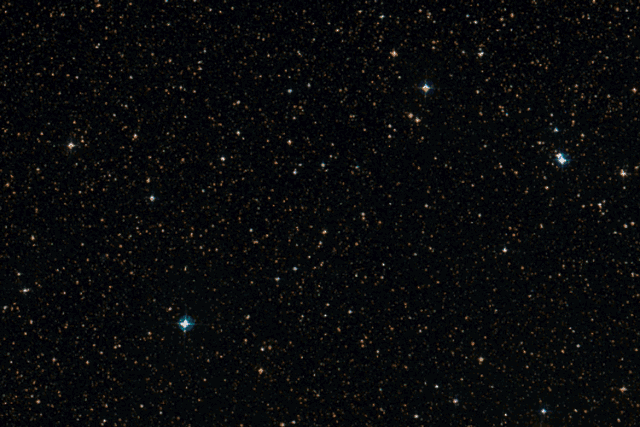How a Distant Alien World Was Saved from an Interstellar Exile
A distant alien world that was potentially on its way into exile in interstellar space was rescued by the gravitational pull of a passing pair of stars, a new study argues.
These findings support arguments that close stellar misses help sculpt planetary systems, the researchers said.
Although Earth and most of its sibling planets have relatively circular orbits around the sun's equator, Pluto and many other dwarf planets have more elongated, tilted orbits. Previous research suggested these distorted features are potentially due to a close approach from another star during the solar system's infancy whose gravitational pull hurled things helter-skelter.
Related: When Will We Find Planet Nine?
"Some of the most distant objects in our solar system, such as comets and the hypothetical Planet Nine, may have been influenced by passing stars too," senior study author Paul Kalas, an astronomer at the University of California, Berkeley, told Space.com.
If stellar flybys could wreak havoc on our solar system, researchers suspected that similar near-misses could reshape other planetary systems as well.
"One of the mysteries arising from the study of exoplanets is that we see systems where the planets are misaligned, even though they are born in a flat, circular disk," Kalas said in a statement. "Maybe a cosmic tsunami hit these systems and rearranged everything about them, but we haven't had proof."
Breaking space news, the latest updates on rocket launches, skywatching events and more!
Now Kalas and his co-author think they have proof that stellar flybys can not only help sling planets away from their stars, but also help keep them from drifting into interstellar space.
The scientists focused on a pair of yellow-white dwarf stars known collectively as HD 106906, located about 300 light-years from Earth in the direction of the constellation Crux. This binary is very young, at only about 15 million years old. (In comparison, our solar system is about 4.6 billion years old.)
Kalas investigates newly formed planetary systems to better understand what happened in the early days of the solar system. He first focused on HD 106906 in 2015 after he and his colleagues discovered it sported a giant planet with an oddly tilted orbit. This world, dubbed HD 106906 b, is about 11 times the mass of Jupiter and is located at least 738 times the distance between Earth and the sun from its stars. Its orbit is tilted about 21 degrees with respect to the disk holding all the other matter around its parent binary.
The 2015 study also found that HD 106906 possessed a lopsided comet belt and an asymmetrical disk of dust. These findings, in combination with HD 106906 b's skewed orbit, suggested that the binary system had experienced major growing pains.
Prior work suggested HD 106906 b was lobbed into an eccentric orbit after passing dangerously close to its parent stars. However, the new paper argues that the gravitational pull of a passing binary system then helped rescue the planet by nudging it back around its parents.
"Stellar flybys have been used to explain the evolution of our own solar system," Kalas said. "HD 106906 offers a rare example where such a flyby happened recently and may have perturbed its distant giant planet."
To hunt down evidence of this flyby, the scientists analyzed data from the European Space Agency's Gaia space observatory, which is creating a 3D map of more than a billion stars across the galaxy with unprecedented precision. The researchers, who could use that data for 461 stars in the same cluster as HD 106906 to deduce their positions backward in time based on their current velocities, discovered a binary system that might have approached HD 106906 close enough 3 million years ago to gravitationally influence its worlds.
"Stars need to pass very close to a planetary system to have significant effect," Kalas told Space.com. "Our calculations show that the flyby stars gave HD 106906 b a gentle gravitational tug rather than a strong one."
Examining the HD 106906 planetary system "is like going back in time to watch the Oort cloud of comets forming around our young sun," Kalas said in the statement. "Our own giant planets gravitationally kicked countless comets outward to large distances. Many were ejected completely, becoming interstellar objects like 'Oumuamua, but others were influenced by passing stars. That second kick by a stellar flyby can detach a comet's orbit from any further encounters with the planets, saving it from the prospect of ejection. This chain of events preserved the most primitive solar system material in a deep freeze far from the sun for billions of years."
In the future, "more accurate measurements for the motions of stars will tell us if the flyby stars had a stronger interaction with the planet," Kalas told Space.com. "We just started a collaboration with a French group to obtain the measurements we need."
The research is described in a paper published Feb. 28 in the Astronomical Journal.
- When Will We Find Planet Nine?
- Planet Nine: Theories About the Hypothetical Planet
- 'Planet Nine': Facts About the Mysterious Solar System World (Infographic)
Follow Charles Q. Choi on Twitter @cqchoi. Follow us on Twitter @Spacedotcom and on Facebook.

Charles Q. Choi is a contributing writer for Space.com and Live Science. He covers all things human origins and astronomy as well as physics, animals and general science topics. Charles has a Master of Arts degree from the University of Missouri-Columbia, School of Journalism and a Bachelor of Arts degree from the University of South Florida. Charles has visited every continent on Earth, drinking rancid yak butter tea in Lhasa, snorkeling with sea lions in the Galapagos and even climbing an iceberg in Antarctica. Visit him at http://www.sciwriter.us

